I'm writing an application that renders every frame of in interleaved stereoscopic 3d. To make this happen, I am writing two fragment shaders: one to render the left eye's frame's odd rows, and one to render the even rows of pixels of the right frame.
I was using OSX's builtin OpenGL Shader Builder application, and I was able to successfully render every odd row as green:

As you can see, the frag code I'm using looks like this:
void main(){
if ( mod(gl_FragCoord.y - 0.5, 2.0) == 1.0){
gl_FragCoord = vec4(0.0, 1.0, 0.0, 1.0);
}
}
However, I wrote a small OpenGL application to test this shader (Btw, this is NVIDIA OpenGL 2.1, OSX 10.6.8):
#include <iostream>
#include <stdio.h>
#ifdef __APPLE__
#include <OpenGL/gl.h>
#include <OpenGL/glu.h>
#include <GLUT/glut.h>
void DrawGLScene(){
glClear( GL_COLOR_BUFFER_BIT | GL_DEPTH_BUFFER_BIT );
glFlush();
glutSwapBuffers();
}
void Shading(){
//Fragment shader we want to use
GLuint oddRowShaderId = glCreateShader(GL_FRAGMENT_SHADER);
std::cout << "Creating the fragment shader with id " << oddRowShaderId << std::endl;
const GLchar *source[] =
{ "void main(){ \n",
" if (mod(gl_FragCoord.y-0.5, 2.0) == 0.0){\n",
" gl_FragColor = vec4( 0.0, 1.0, 0.0, 1.0 );\n",
//" gl_BackColor = vec4( 0.0, 1.0, 0.0, 1.0 );\n"
" }\n",
"}\n"
};
std::cout << "Shader source:\n" << source[0] << source[1] << source[2] << source[3] < < source[4] << std::endl;
std::cout << "Gathering shader source code" << std::endl;
glShaderSource(oddRowShaderId, 1, source, 0);
std::cout << "Compiling the shader" << std::endl;
glCompileShader(oddRowShaderId);
std::cout << "Creating new glCreateProgram() program" << std::endl;
GLuint shaderProgramId = glCreateProgram(); //Shader program id
std::cout << "Attaching shader to the new program" << std::endl;
glAttachShader(shaderProgramId, oddRowShaderId); //Add the fragment shader to the program
std::cout << "Linking the program " << std::endl;
glLinkProgram(shaderProgramId); //Link the program
std::cout << "Using the shader program for rendering" << std::endl;
glUseProgram(shaderProgramId); //Start using the shader
}
void keyboard(int key, int x, int y){
switch(key){
case 's':
Shading();
break;
case 'q':
exit(0);
break;
}
}
void idleFunc(){
glutPostRedisplay(); //Redraw the scene.
}
int main(int argc, char** argv){
glutInit(&argc, argv);
glutInitWindowPosition(100, 100);
glutInitWindowSize(1000,1000);
glutInitDisplayMode(GLUT_RGBA | GLUT_DOUBLE | GLUT_DEPTH);
glutCreateWindow("anaglyph test");
glutDisplayFunc(DrawGLScene);
glutSpecialFunc(keyboard);
glutIdleFunc(idleFunc);
glutMainLoop();
}
This is the output I get from running the code:
 I have a feeling I may not be compiling and
I have a feeling I may not be compiling and glUsePrograming the fragment shader correctly.
